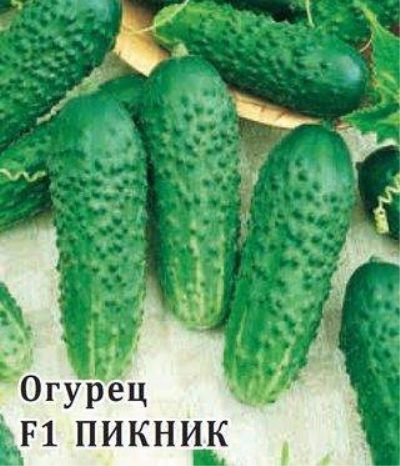
- Authors: Gavrish S.F., Portyankin A.E., Shamshina A.V.
- Year of approval: 2003
- Growth type: vigorous, indeterminate
- Branching: the average
- Fruit weight, g: 90-100
- Fruit length, cm: 10-12
- Fruit color: dark green with stripes up to 1/3 of the length
- Ripening terms: early
- Fruit shape: cylindrical
- Fruit taste: great
Cucumber Picnic attracts the attention of vegetable growers with its unusually high yield. The hybrid is one of the five most demanded varieties. However, the plant is demanding in care, especially in irrigation and additional nutrition. If all conditions are met, you can get a large harvest of tasty and healthy vegetables.
Description of the variety
Cucumber Picnic has gained particular popularity among vegetable growers due to the following benefits:
- early maturity;
- high productivity;
- parthenocarpic view;
- with competent agricultural technology, the bushes are not affected by powdery mildew and cladosporiosis;
- good transportability, the plant tolerates transportation without loss;
- cucumbers do not outgrow if you are late with the collection.
There are few disadvantages:
- high water demand;
- it is almost impossible to get seed from hybrid varieties, since they do not inherit parental genes;
- the vegetable requires a lot of sun and frequent weeding in order not to be affected by parasites.
Characteristics of the appearance of plants and zelents
The culture of the indeterminate type reaches a height of 2-2.5 m. Despite the strong foliage, the branching is average. Feminine type of flowering. At each node, from 3 to 5 fruits are formed. Leaves of medium size with a smooth surface, irregularly serrate at the edges.
Cucumbers are short, gherkin type, cylindrical in shape. On average, the length of one green leaf is 10-12 cm, weight is 90-100 g. The elastic and delicate skin of a rich dark green color has stripes up to 1/3 of the length of the fruit. The mid-lumpy surface is covered with white thorns.
Purpose and taste of fruits
The taste of the Picnic is excellent, the fruits grow with a rich cucumber aroma, without bitterness. The flesh is crispy and refreshing. The variety has high commercial qualities. The vegetable is considered versatile in cooking. Suitable for both fresh cooking and preservation.
Maturation
The hybrid is characterized by early terms of fruiting, beginning on 42-45 days with the appearance of the first shoots. In rainy and cool climates, the ripening process takes up to 50 days. Zelentsy on the liana ripen in turn, but in general, the return of the fruits is friendly. Long-term fruiting, from June to August.
Yield
The culture is high-yielding. On average, from 1 sq. m receive 10.9-11.7 kg of vegetables.
Growing regions
It is recommended to grow a Picnic in the North, North-West, Central, Volgo-Vyatka, TsChO, North Caucasian, Middle Volga regions. The variety shows the best yield there.
Landing scheme
Due to the fact that the plant is tall, when growing, you should take into account the planting scheme, which should be 50x50 cm. m you can plant no more than 3 bushes. With this arrangement, the bushes will not thicken each other.
Growing and caring
Cucumber Picnic is a rather demanding crop to care for. The variety requires constant feeding, weeding and hilling of the beds, generous watering, the formation of bushes and protection from pests.
Seeds begin to germinate rather late, since the plant is sun- and heat-loving.In open ground, the seed is planted at the end of May, and the seedlings begin to germinate at the end of April - beginning of May. The grown seedlings are transferred to open soil and a greenhouse in late May - early June. Peat cups are the best option for germinating seeds.
A plot for cultivation is being prepared in the fall. The soil is carefully dug up, disinfected with a disinfectant from fungi and bacteria, and rotted manure is introduced. A few days before the direct planting of seedlings, the soil is weeded, loosened, enriched with compost, wood ash and sawdust. Seedlings begin to be planted in a permanent place at the age of one month, each bush should have at least 3 full leaves.
The hybrid is hygrophilous. Watering is carried out daily. The water should be kept warm. The picnic does not tolerate a prolonged drought. The variety responds best to mineral dressings, which are applied 3 times per season. Start the event on the 3rd day after planting the seedlings in a permanent place and repeat every two weeks.
The first feeding is done with superphosphate, the second - with chicken droppings or rotted mullein, the third - with sodium sulfate or potassium. With a lack of nutrition, the plant will begin to shed inflorescences.
Soil requirements
The picnic grows well on crumbly and enriched soils (sandy loam or fat chernozem) on a small hill where there is no stagnation of water.

In order to collect strong, tasty and beautiful cucumbers on your site, you need to make top dressing. Lack of nutrients can negatively affect the appearance of the plant and significantly reduce the yield. Fertilize cucumbers with organic fertilizers in combination with mineral fertilizers. With the right balance of these components and adherence to the fertilizing schedule, the cucumber yield will be maximum.
Disease and pest resistance
The vegetable is good against most diseases. However, due to its great love for moisture, the variety is often affected by white and gray rot. As a preventive measure, the bushes are sprayed with fungicides. Another lover of cucumber plantings is aphids. It is fought with a solution of wood ash or dolomite flour.

Despite their popularity, cucumbers are often attacked by diseases and pests. From them, cucumber plantings often die before the start of fruiting. In order to prevent this from happening, it is necessary to try to prevent ailments or get rid of them at the very beginning, having studied in detail their causes of occurrence, signs and methods of treatment.





























































































